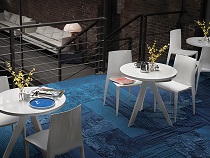 CHICAGO—Carpet tile manufacturer Interface introduces Net Effect, inspired both by the ocean’s life-giving power and its plight—marine life and habitats that are endangered by discarded fishing nets, acidification, over-fishing, pollution and climate change. Net Effect debuted at NeoCon this week in Interface’s Chicago Merchandise Mart showroom, and will roll out globally throughout 2013. Manufacturing will take place locally in Interface’s North American, European, and Asia-Pacific facilities. This uniform global production allows for specification on six continents.
CHICAGO—Carpet tile manufacturer Interface introduces Net Effect, inspired both by the ocean’s life-giving power and its plight—marine life and habitats that are endangered by discarded fishing nets, acidification, over-fishing, pollution and climate change. Net Effect debuted at NeoCon this week in Interface’s Chicago Merchandise Mart showroom, and will roll out globally throughout 2013. Manufacturing will take place locally in Interface’s North American, European, and Asia-Pacific facilities. This uniform global production allows for specification on six continents.
The collection was born of Net-Works, an innovative global business and conservation association between Interface and the conservation charity the Zoological Society of London (ZSL). Net-Works was launched in the Danajon Bank area of the Philippines in 2012 to tackle two distinct issues: first, to address the growing environmental problem of discarded fishing nets in some of the world’s poorest coastal communities, and second, to help solve the problem of finding a viable waste stream to feed the company’s ambitious post-consumer nylon recycling goals.
Working closely with Aquafil, a key Interface supplier that has refined the technology to recycle nylon waste into new nylon carpet fiber, and NGO Project Seahorse Foundation for Marine Conservation Inc., Net-Works is advancing the company’s goal of closed-loop manufacturing. End of life fishing nets recovered from the fishing industry supply chain represent some of the world’s cleanest and most abundant supply of post-consumer nylon, the same raw material as carpet yarn. Developing a local reclamation system for these nets, Net-Works is improving residents’ livelihoods and providing the impetus for new community banking institutions that offer long-term solutions to poverty.
Toward Being a Restorative Enterprise
“Interface’s business is built around inspiration, innovation and the pursuit of true sustainability—economic, environmental and social,” said Chip DeGrace, executive creative director for Interface. “Products like Net Effect—and programs like Net-Works—demonstrate how creative thinking can change the way we do business and move us closer to the ultimate goal of being a restorative enterprise.”
The Net Effect product collection provides a subtle visual reminder of the sea on its surface, with a design reminiscent of swirling currents. Created by David Oakey, owner of David Oakey Designs, an exclusive designer for Interface, the collection of six modular carpet tile options embraces sustainability in construction and concept.
“Aesthetically, we wanted Net Effect to capture the positivity of the Net-Works partnership and the beauty of the waters it’s so closely tied to,” said Oakey. “This collection connects people with the emotions and memories associated with the beach, but their enjoyment is its most superficial benefit. What’s beneath the surface—including the product’s ties to the good work Net-Works is doing—is what makes it extraordinary.”
Tiles Capture the Fluidity of Water
Net Effect’s three 50 cm square tiles—comprising a neutral ground, transition tile and textural accent—evoke the sea with a texture that references the moment when waves wash over land. The three tiles can be combined to create design elements including continuous transitions, borders and inset area rugs. The square tiles’ organic forms pair with three 25 cm-x-1 m skinny plank styles that capture the fluidity of water and convey the expanding and contracting rhythms of the tides with more linear patterns. The square and plank tiles’ shared coastal color palette of two blues and six neutrals was drawn from the depths of the ocean, and the sun-and-salt-bleached wood and stone found on shore.
Reflecting Interface’s abiding Mission Zero promise to eliminate any negative impact it may have on the environment by 2020, Net Effect contains up to 81 percent recycled content with 100 percent recycled content yarn. The yarn is made from various sources including used carpet fluff harvested from Interface’s ReEntry program, commercial fishing nets and, shortly, nets from the Net-Works project in the Philippines. Since 1995, ReEntry has processed more than 268 million pounds of used carpet tile and broadloom globally.
As for Net-Works, it provides significant economic benefits to the fishing communities involved, protects marine life and helps clear vulnerable beaches and endangered reefs, thereby providing environmental, economic and social benefits not usually synonymous with carpet tile manufacturing. Interface will promote Net Effect through a social media engagement campaign that encourages its design audience to share examples of the impact their design and personal choices have on the world around them. A hashtag has been created, #IFneteffect, to help foster the conversation, which has Facebook, Twitter, Pinterest and Instagram components.
Go to Interface.





